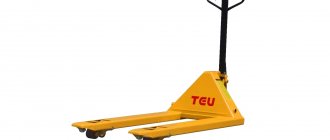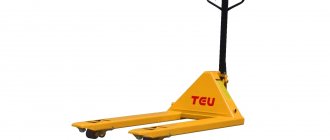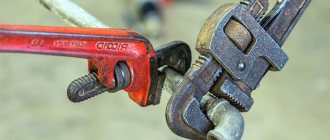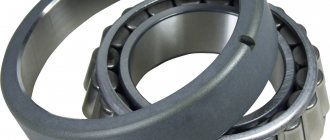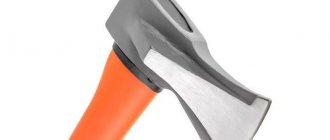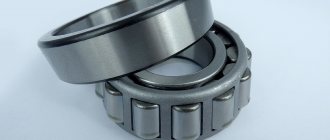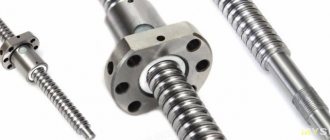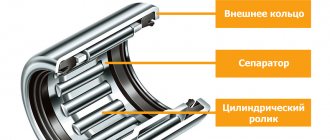Nowadays, radial ball bearings with one row of rolling elements are the most common type of shaft and axle supports. These products are used in a wide variety of components and mechanisms where rotation occurs at a fairly high frequency and the values of radial forces are relatively small. Ball bearings of this type are in demand in the automotive and mechanical engineering, instrument making, food and pharmaceutical industries, in the energy sector and in the manufacture of household appliances. The simple non-separable design makes these parts affordable and easy to maintain. If such a ball bearing is manufactured in accordance with high quality requirements, correctly installed and lubricated, then its service life is very long.
Design and features of single-row ball bearings
A single-row radial ball bearing consists of an outer and inner ring, spherical bodies that provide rolling and a separator holding them. The balls in such supports move along tracks of considerable depth, which ensures an increased area of their contact with the surface of the rings. The load transmitted to the support by the shaft is distributed fairly evenly within the unit, so that such a part can also be used as an angular contact bearing if the axial load is small. Separators for parts of this type can be made of steel, non-ferrous metal alloys, and polymer materials. They can be either stamped from a thin sheet or cast, providing the most durable fixation of the rolling elements. Stamped parts occupy a minimum of space in the unit, which makes it possible to place more lubricant between the rings. But do not forget that the most durable are cast cages made of steel or brass. The ball radial unit can be either open or closed. The protective element, which looks like a washer, covers the ends of the product, preventing dirt and moisture from entering the internal volume of the unit. But the main advantage of closed models is that they are less demanding to maintain. The grease in them is protected from external adverse factors and its accidental loss during operation is impossible. Many companies offer to buy a maintenance-free type of support, in which lubricant is added at the factory for the entire service life of the product. This series of products has proven itself in the automotive and food industries, where leakage of lubricant is unacceptable for sanitary reasons. As the demand for open and sealed ball bearings in various fields of production is steadily growing, many world-famous brands such as SKF, NSK and Timken are constantly expanding their range, offering various unusual product options. Today it is not difficult to purchase bearings with a square hole, hybrid models with ceramic and polymer elements, and even completely plastic options. Stainless steel bearings that can operate in a humid environment and under the influence of certain aggressive substances, such as solutions of acids and alkalis or sea water, are in great demand on the world market. Miniature stainless steel bearings are an indispensable component of washing machines, food processors and other popular household appliances. Heat-resistant supports are also available for use at elevated temperatures. The rings, balls and separators of these models are made of alloys with a minimum coefficient of thermal expansion. GOST offers single-row radial ball bearings in the widest range of sizes. Manufacturers produce both large-diameter ball bearings for the needs of mechanical engineering and energy, and miniature bearings for use in devices, home equipment and individual vehicles. It is safe to say that ball bearings are the most diverse group of supports in size.
Thrust roller
We see another type of bearings, their names and parameters in the picture:
Designed for axial loads, like all caster structures. Between the two rings there are bodies of rotation, which are located in separators. There are two varieties, depending on the shape of these elements; let’s look at the subspecies.
Roller cylindrical
The rollers are cylindrical in shape. They are stable and very dense, due to the fact that they stay firmly in place and offer a large proportion of the contacting surface, unlike ball bearings, they work with large parts.
Pros:
- Maximum load capacity.
- Wide range - there are single-row and double-row.
- High rigidity.
- Possibility of production in very small sizes.
Minuses:
- They react noticeably to changes.
- Poorly adapted to high speeds.
Roller conical
Similar to the previous ones, but the rolling bodies are not cylinders, but cones. This is a very practical design, rarely used so far. Its advantages:
- There is no slipping of elements when moving.
- They can absorb both radial and axial loads at the same time.
- Stable position of the rollers, without shifts.
- Effective stress distribution.
The disadvantage is mainly the price, because the design is not yet widely produced.
Advantages and disadvantages of ball single-row radial bearings
The undeniable advantages of radial single-row ball bearings include their high speed characteristics. These supports have proven themselves to be excellent in mechanisms with high shaft rotation speeds. Consumers are also attracted by the moderate price of these parts, due to the relatively simple production technology, as well as the ability to choose the size and design from a variety of proposed options. But these products also have a number of important disadvantages: • Bearings using a ball do not tolerate moment loads well; • Single-row type of supports does not have sufficient axial rigidity; • The carrying capacity of the products is limited; • Susceptibility to pollution; • The supports do not withstand vibrations and shocks well. In some cases, a double-row bearing, which is stiffer and more load-bearing, helps out. But, if the operating conditions of the unit are quite severe and there are doubts about the reliability of the ball design, experts recommend using roller models, the internal diameter and external size of which correspond to the parameters of radial rolling bearings with balls.
Marking and dimensions according to GOST
Requirements for components and parts are formulated by GOST. Rolling bearings are described by GOST 520-2002.
The symbols are based on the following parameters:
- the diameter that the bearing bore has;
- series of widths (or heights) and series of diameters;
- types of bearings;
- technical implementation.
How to correctly determine the dimensions of rolling bearings based on the markings? The notation table will help you cope with this task.
All the above parameters are indicated by signs (or numbers).
What numbers the bearing marking consists of depends on the places they occupy in its symbol, if read from left to right: GOST for plain bearings
| The first and second numbers indicate the hole diameter (if we are talking about a hole diameter greater than or equal to 10 mm). |
| The third digit indicates the series of diameters. |
| The fourth digit determines the type of bearing. |
| The fifth and sixth digits give an idea of the design. |
| The seventh digit indicates a series of widths (or heights). |
Selection of bearings
In modern industry, single-row radial ball bearings, the table of series sizes is represented by a huge number of options. To make the selection of parts as simple as possible, their marking is carried out in strict accordance with domestic GOST standards and global ISO standards. Designation systems, both domestic and global, provide comprehensive information about the part, including its dimensions, accuracy class, design features and recommended operating conditions. The bearing marking is applied to the outer ring in such a way that it can be easily identified and read. The exception is miniature parts, on the surface of which there is not enough space for inscriptions. These bearings have all the necessary information printed on the packaging. Sometimes large diameter supports also lack markings on the rings. This is typical for precision bearings of the highest precision, any irregularities on the surface of which, including embossed symbols, are unacceptable. Selecting ball bearings is a difficult task even for an experienced mechanic. The huge selection of options presented by popular brands can make even a stern professional become confused. To make it easier to select parts for different types of use, our website contains a table of analogues, from which you can choose an alternative to even a rare or discontinued product. The managers of our online store are always happy to come to your aid if you have any difficulties in choosing products. Many companies and individuals from different parts of Russia, as well as Belarus and Kazakhstan, prefer to purchase products from us. Reasonable prices recommended by manufacturers, a huge selection, official guarantee and prompt delivery make our company an ideal supplier of bearings for any application.
APPLICATION. (Introduced additionally, Amendment No. 1).
Editor M.I. Maksimova Technical editor O.N. Vlasova Proofreader V.I. Varentsova Computer layout I.A. Naleykina
Ed. persons No. 02354 dated July 14, 2000. Delivered for recruitment on August 27, 2003. Signed for publication on October 22, 2003. Uel. oven l. 1.40. Academician-ed.l. 0.95.
Circulation 91 copies. From 12440. Zak. 324.
IPC Publishing House of Standards, 107076 Moscow, Kolodezny per., 14. https://www.standards.ru e-mail Typeset and printed in IPC Publishing House of Standards
Table 1
Ultralight diameter series 8, normal width series 1 and wide width series 2
Dimensions, mm
| Designation bearings cove | d | D | IN | G | Weight, kg = | Designation bearings cove | d | D | IN | G | Weight, kg = |
| 1000083 | 3 | 1 | 2 | 0,3 | 0,0003 | 1000817 | 85 | 110 | 13 | 1,5 | 0,29 |
| 2000083 | 3 | 1 | 2,5 | 0,3 | 0,0004 | 1000818 | 90 | 115 | 0,30 | ||
| 1000084 | 4 | 9 | 0,0007 | 1000819* | 95 | 120 | 0,32 | ||||
| 1000085 | 5 | 11 | 3,0 | 0,0012 | 1000820 | 100 | 125 | 0,34 | |||
| 1000086 | 6 | 13 | 3,5 | 0,0020 | 1000821* | 105 | 130 | 0,45 | |||
| 1000087 | 7 | 14 | 0,0022 | 1000822 | 110 | 140 | 16 | 0,60 | |||
| 1000088 | 8 | 16 | 4,0 | 0,4 | 0,0030 | 1000824 | 120 | 150 | 0,65 | ||
| 1000089 | 9 | 17 | 0,0034 | 1000826 | 130 | 165 | 18 | 2,0 | 0,93 | ||
| 1000800 | 10 | 19 | 5,0 | 0,5 | 0,0055 | 1000828 | 140 | 175 | 1,08 | ||
| 1000801 | 12 | 21 | 0,007 | 1000830 | 150 | 190 | 20 | 1,43 | |||
| 1000802 | 15 | 24 | 0,008 | 1000832 | 160 | 200 | 1,49 | ||||
| 1000803 | 17 | 26 | 0,009 | 1000834 | 170 | 215 | 22 | 2,00 | |||
| 1000804 | 20 | 32 | 7,0 | 0,020 | 1000836 | 180 | 225 | 2,03 | |||
| 1000805 | 25 | 37 | 0,022 | 1000838 | 190 | 240 | 24 | 2,5 | 2,6 | ||
| 1000806 | 30 | 42 | 0,027 | 1000840 | 200 | 250 | 2,7 | ||||
| 1000807 | 35 | 47 | 0,031 | 1000844 | 220 | 270 | 3,0 | ||||
| 1000808 | 40 | 52 | 0,035 | 1000848 | 240 | 300 | 28 | 3,0 | 4,5 | ||
| 1000809 | 45 | 58 | 0,043 | 1000852 | 260 | 320 | 4,8 | ||||
| 1000810 | 50 | 65 | 0,057 | 1000856 | 280 | 350 | 33 | 7,4 | |||
| 1000811 | 55 | 72 | 9,0 | 0,091 | 1000860 | 300 | 380 | 38 | 3,5 | 10,5 | |
| 1000812 | 60 | 78 | 10 | 0,12 | 1000864 | 320 | 400 | 11,8 | |||
| 1000813 | 65 | 85 | 1,0 | 0,13 | 1000868 | 340 | 420 | 12,0 | |||
| 1000814 | 70 | 90 | 0,18 | 1000876 | 380 | 480 | 46 | 20,0 | |||
| 1000815 | 75 | 95 | 0,19 | 1000892 | 460 | 580 | 56 | 4,0 | 36,3 | ||
| 1000816 | 80 | 100 | 0,22 |
Ultralight diameter series 9, normal width series 1
Dimensions, mm
| table 2 | |||||||||||||||||||||||||||||||||||||||||||||||||||||||||||||||||||||||||||||||||||||||||||||||||||||||||||||||||||||||||||||||||||||||||||||||||||||||||||||||||||||||||||||||||||||||||||||||||||||||||||||||||||||||||||||||||||||||||||||||||||
Extra light diameter series 1, narrow width series 7
|
Installation
Recommendations for installation:
- check the assembly for visual defects, rotate it;
- measure the radial clearance;
- the shaft needs to be looked at for the straightness of its axes;
- the alignment should not exceed that allowed in the technical accompanying documentation;
- The mating surfaces must be clean, dry, and, if necessary, treated with lubricant.
